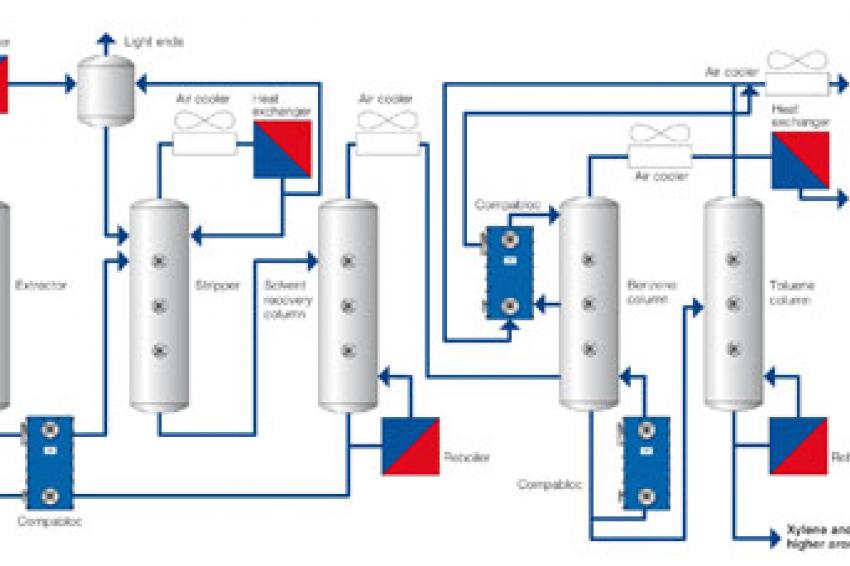Where Size Really Counts
Compact Heat Exchangers Make Reducing CO2 Emissions Profitable
Win-win Situation - Today, many industries are asking themselves how they can contribute to a better environment by reducing CO2 emissions, while remaining efficient and cost competitive. One solution, where feasible, is to install compact heat exchangers instead of bulky, less energy efficient shell-and-tube heat exchangers. According to Alfa Laval, compact heat exchangers can help plants consume less energy, reduce CO2 emissions, and increase uptime.
Nearly one third of the world's energy consumption and 36 % of its carbon dioxide (CO2) emissions are attributable to manufacturing industries. Reducing emissions of greenhouse gases (GHG), such as carbon dioxide, is a topic in sharp focus in our society today.
Happily, we see a strong desire and determination among many of the major industrial players to contribute to a better environment by improving their energy efficiency and thereby reducing emissions of GHG.
With CHEs It Pays To Reduce CO2 Emissions
At Achema 2009, Alfa Laval introduced the Compabloc 120 fully welded compact heat exchanger (CHE), the largest member of its Compabloc family. Like the other family members, the highly compact Compabloc 120 makes reducing CO2 emissions not just achievable, but profitable due to the energy savings it offers, combined with low maintenance costs. The resulting short payback time on the investment means that plant owners or operators do not have long to wait before this solution starts contributing to their bottom line - and reducing CO2 emissions at the same time.
What's The Secret?
Compabloc is a proven technology. An estimated 20,000 units have been sold worldwide in recent years. Installation of shell-and tube heat exchangers (S&Ts) demands a large amount of space, thereby limiting the possibility to save energy in existing plants. The compact design of the Compabloc means a smaller footprint, and/or higher capacity in the same space. In many applications one Compabloc can replace one or several S&Ts, providing the same or higher capacity at a lower investment cost.
Maximum Heat Recovery
The Compabloc design offers maximum heat recovery, due to a combination of high turbulence and counter-current flow which, in turn, allows significant energy savings. Customers can recycle valuable energy for a wide range of uses rather than producing or buying more, which benefits their bottom line.
The principle is simple. Liquids or vapors flow through channels between corrugated plates, creating a high degree of turbulence in the media. This results in better heat transfer between the media. A counter-current flow enables crossing temperature programs, where the cold fluid can be heated to temperatures very close to those of the hot fluid. The closer the temperature approach between two fluids, the more heat is recovered.
Reduced CO2 Emissions
The fact that Compabloc 120 contributes to improving the energy efficiency of customers' processes benefits the environment, since less steam (most commonly generated by fossil fuels) is required in the process. This, in turn, allows a reduction in CO2 emissions from the plant. In addition, the Compabloc 120's low hold-up volume gives improved process control and efficiency compared to shell-and-tube technology, thus increasing the overall efficiency of the plant even further.
Less Maintenance, More Uptime
High channel turbulence also means less fouling, less maintenance and thus more uptime, which in turn raises plant capacity. The removable frame of the Compabloc 120 and its easy-to-access plate channels that can be cleaned by hydroblasting, make it much easier and faster to clean than an S&T unit. It can also be cleaned in-line, using Cleaning-in-Place (CIP) equipment and detergents. In some applications, no cleaning is needed.
Everyone Wins
Alfa Laval firmly believes that increased usage of CHEs will not only significantly benefit the environment but also cut operating costs and thereby improve the profitability and competitiveness of the industry. "Using CHEs enables our customers to reduce their CO2 emissions here and now and contribute to a better environment. At the same time they improve their plant performance and bottom line result," says Carina Resare, Market Unit Manager Petrochemicals at Alfa Laval.






